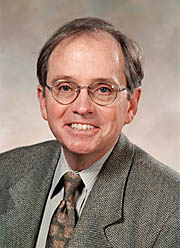
February 28, 2000
Two UCSC faculty awarded UC Presidential Chairs
By Tim Stephens and Barbara
McKenna
Two UCSC faculty members--professor of computer science David Haussler and professor
of philosophy David Hoy--have been appointed to UC Presidential Chairs on the Santa
Cruz campus.
 |
| David Haussler (above) and David Hoy Photos: Don Harris |
 |
"I am already looking forward to following the work these two outstanding scholars will conduct as Presidential Chairs," Greenwood said. "Both professors crafted exceptional proposals that will support research by faculty and graduate students across disciplinary boundaries. Their projects have the potential to generate activity that will have an impact well beyond the borders of the campus and long after the chair appointments end."
The Santa Cruz campus has appointed three Presidential Chairs in the past: Professor Hayden White, Historical Studies (1983-88), Professor Richard Wasserstrom, Moral Philosophy (1988-91), and Professor Angela Davis, African American and Feminist Studies (1995-97).
The president of the University of California supports Presidential Chairs on each of the nine UC campuses through an endowment established in 1981 by the UC Regents. The positions are offered to distinguished members of the university's faculty and are intended to encourage new or interdisciplinary program development or to enhance quality in existing academic programs.
Haussler received the award in recognition of his outstanding scholarship and continuing efforts to develop a graduate program in bioinformatics at UCSC. Bioinformatics is a new discipline that has emerged at the intersection of computer science and biotechnology, bringing the power of advanced computational techniques to bear on complex problems in molecular biology. Haussler, who directs UCSC's Center for Biomolecular Science and Engineering, heads a prominent research group in bioinformatics and is working to establish graduate and undergraduate degree programs in this field.
He plans to use the resources that accompany the Presidential Chair to fund three fellowships for graduate students in bioinformatics. "Santa Cruz has an excellent opportunity to develop a unique program with a focus on the information technology and engineering technology that advance the field of biomolecular engineering," he said.
Haussler joined the UCSC faculty in 1986 after several years on the faculty of the University of Denver. He received his B.A. in mathematics from Connecticut College, M.S. in applied mathematics from California Polytechnic State University at San Luis Obispo, and Ph.D. in computer science from the University of Colorado at Boulder.
Haussler has published papers in 30 different journals in computer science, mathematics, statistics, physics, and molecular biology, and his work has been cited more than 2000 times in journal articles and papers from scientific conferences. He was one of the founders of the field of computational learning theory, which now has three annual conferences in the U.S., Europe, and Japan, and he is a fellow of the American Association of Artificial Intelligence. In the early 1980s, he worked on computer analysis of the first viral and bacterial genome sequences with colleagues at the University of Colorado. He is known for introducing to the field of bioinformatics a now widely used technique called hidden Markov modeling.
Hoy, who came to UCSC in 1981, has a long-standing history of initiating interdisciplinary approaches to critical thinking. In addition to more than 50 essays, he has authored and edited several books, among them, Critical Theory (with Thomas McCarthy), Foucault: A Critical Reader, and The Critical Circle (on literary theory and philosophical hermeneutics). A 1998 recipient of UCSC's Excellence in Teaching Award, Hoy has directed five National Endowment for the Humanities (NEH) Summer Institutes at UCSC and has received well over $1 million in grants to train college professors to become better teachers.
Hoy's project will support three research clusters--one for each year of the duration of his appointment. Titled, "Critical Theory," "Consciousness, Meaning, and Embodied Agency," and "The Philosophy and History of Science, Mathematics, and Technology," the clusters will be structured as multidisciplinary collaborative groups made up of faculty and graduate students. The clusters will, as Hoy says, "close gaps that are both geographical and disciplinary."
Hoy notes, "The research clusters will also lead to interdisciplinary publications that will try to break down the barriers between entrenched ways of thinking. These research clusters will improve teaching by finding ways to challenge the current practice of making graduate students into narrow specialists at a time when we really need broader horizons and different ways of thinking."
Hoy has already secured tentative commitments to the project from faculty in such varied disciplines as anthropology, art history, biology, engineering, linguistics, literature, mathematics, philosophy, physics, and psychology. Participants will focus on the designated research topic, meeting weekly as a group and one-on-one with Hoy. Funding from the chair will support stipends for graduate students as well as academic release time to enable participants to focus fully on this collaborative research.
In addition to supporting research and publication on these topics, the three clusters will spawn other projects. For instance, Hoy plans to use the imminent publication of his book, Critical Resistance, as a vehicle that would provide the framework for another book of related essays, edited by Hoy and written by cluster participants, including graduate students. And, Hoy adds, "The themes of this research cluster could also be the basis for a proposal to the NEH for another Summer Institute."
Similar outcomes will follow in the second year as he completes his book entitled, "A History of Consciousness." "My principal goal," Hoy says "is to increase the visibility of UCSC as a source of creative multidisciplinary research and as a place that fosters bold ideas."